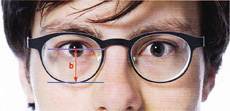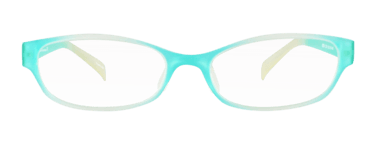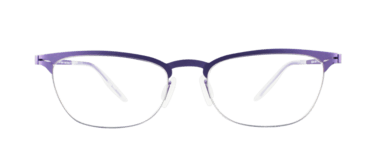Poorly Adjusted Glasses
 |
|
Poorly adjusted glasses can become a real headache. |
More than half of 30 tested opticians does something wrong. Some glasses should not have even left the store, say the experts of the Consumentenbond (Netherlands’ Consumers Association). Just a nice frame with good lenses is not yet a properly finished product.
An optician that has carefully edged the lenses and accurately mounted them in the frame ruins everything if he/she does not properly fit the glasses to the client’s head. Too many optical stores rush through this all too important part, as evidenced by research conducted by the Consumentenbond (the Dutch Consumers Association). Of the 30 pairs of glasses, 12 were ill-fitting and should not have left the store to begin with, concluded the experts. Out of the remaining 18, 14 could stand improvements in regards to wearer comfort, but were acceptable. Only 4 pairs of glasses were able to pass the test as being properly adjusted.
| Optician's Work |
|
The optician (or optometrist or ophthalmologist) determines which lenses his customer needs, recommends an appropriate frame to the customer, measures the distance between pupils, and sends the resulting prescription to the lens manufacturer. The manufacturer is responsible for sending the lenses with the appropriate power and other requirements to the optician, who will then inspect the lenses. Then the optician edges the lenses in such a way that the cylinder’s axis is in the correct position and the optical centers are at the proper fitting height and pupillary distance. Then he mounts the lenses in the frame and adjusts the glasses properly to the customer’s head. The Consumentenbond sent a mystery shopper to 30 optical stores with the same prescription from an optometrist. The resulting 30 pairs of glasses received were evaluated by 2 experts: how is the fit and finish, and are they adjusted properly for the customer? The experts, both optometrists with a lot of experience in optical stores, applied the quality standards used in the optical industry and education programs. During his visit at each store, the mystery shopper recorded the advice give to him and inquired casually about the education of the employee that assisted him. |
The experts are especially dissatisfied about the distance between the eye and the lenses. Oftentimes this distance was much too large, preventing the wearer from seeing properly through the glasses. The optician could have and should have solved this problem by simply adjusting the nose pads. Another downfall is the length of the legs of the glasses, properly known as the temples. The temples were generally too short to securely keep the glasses on the wearer’s head. Finally, the customer often left the store while being able to feel the bridge of the glasses on his nose, which can cause an allergic reaction.
In other aspects, the opticians do much better, but even there the survey brings imperfections to light. More than half of the optician’s visited, fails to work sufficiently accurate on one or more aspects.
The power of the lenses matches precisely with the prescription in 12 of the glasses. The remaining lenses are within the accepted range used by opticians and the optical education programs: 0.12 diopters stronger or weaker than the prescriptions.
The optician is expected to edge the glasses in such a way that the axis of the cylinder is in the right position, in order to properly correct astigmatism. A capable and careful optician can mount the cylinder within 1 degree of the prescribed axis. The axis for all 30 pairs of glasses used for this study deviated more than 1 degree from the prescription, but was smaller than the accepted deviation used in the education programs. The deviation allowance varies per prescription and is calculated by means of a specific formula.
 |
|
An incorrect fitting height can lead to a number of complaints. |
Furthermore, an optician has to edge and mount the lenses in the frame in such a way that the optical center of the lens is directly in front of the pupils, both in terms of fitting height and pupillary distance. One of the pairs of glasses does not meet the required fitting height: the optical centers of the lenses are mounted a full 5 mm too high. According to the education’s guidelines, the discrepancy may not be more than 2 mm. This happened even though the shop assistant was extremely aware of the importance of a proper fitting height and took this measurement precisely. The mystery shopper reported, “The assistant acknowledged that it’s important for this measurement to be exact, or else I’d be dissatisfied with the glasses.” This is true, because optical centers that are mounted to high force the wearer to constantly bow their head in order to properly see through the glasses, while optical centers that are mounted too low require the wearer to continually crane their neck. This can in turn cause neck-complaints, not to mention a cantankerous mood.
 |
|
It's very important that your glasses are fitted to your correct PD. |
Unfortunately, there’s more bad news. The pupillary distance in 8 of the pairs is incorrect, meaning that the optical centers are either too close or too far apart. One of the glasses where this mistake was detected was a pair of glasses that was available for pick up within an hour. This mistake disrupts the ability of both eyes to work together and can lead to double vision and headaches.
What about the actual mounting of the lenses in the frame? The experts unanimously agreed that 3 pairs of glasses were “undeliverable” because gaps were detected between the lens and frame, 5 pairs could stand some improvement but could pass the inspection, and the remaining 22 received a good grade.
Three opticians let uncertified assistants measure the customer’s pupillary distance, 4 leave the adjusting of glasses to uncertified staff. The adjustments made by these 4 were without exception below par, but even certified staff made mistakes during this process.
Most optical stores did not require (partial) payment upon ordering. Some stores asked for a set amount of €50, and the rest asked for payment of the entire amount. Opticians that are member of the trade association Nuvo can ask for a deposit up to 25% of the total amount due. One of these members did not follow this rule.
 |
|
23 out of 30 stores delivered the glasses according to the agreement. |
Some stores violated the delivery time agreement. All 30 stores promised to deliver the glasses within a week and a half; 23 kept this promise. Of the remaining 7, 4 stores were able to deliver the glasses after 2 weeks and 3 delivered after 2.5 weeks. One store had promised the glasses within a week but ended up delivering after a staggering 3 weeks.
Two week adjustment period
New glasses take up to 2 weeks to get used to. If there are still complaints after that, it is highly recommended that the customer goes to the dispensing optician to ask what is wrong and how the problem can be solved. Adjustments often come with a 2 month warranty. Manufacturer’s warranties often extend one or two years, depending on the store. The customer can always get a second opinion from another optician or optometrist. If the customer still cannot find a suitable solution with the optician, a request for arbitration can be submitted to the optician’s trade association.
Tips & Facts
|
Upon purchasing:
|
After adjustments:
|
|
While cleaning
|
|
PL version article, “Beroerd afgestelde brillen”, appeared in the July/August 2010 edition of the Dutch consumer’s guide Consumentengids on pages 13-15. Click here to see original translation (PDF). Click here for original Dutch article (PDF).
Recommended for you













